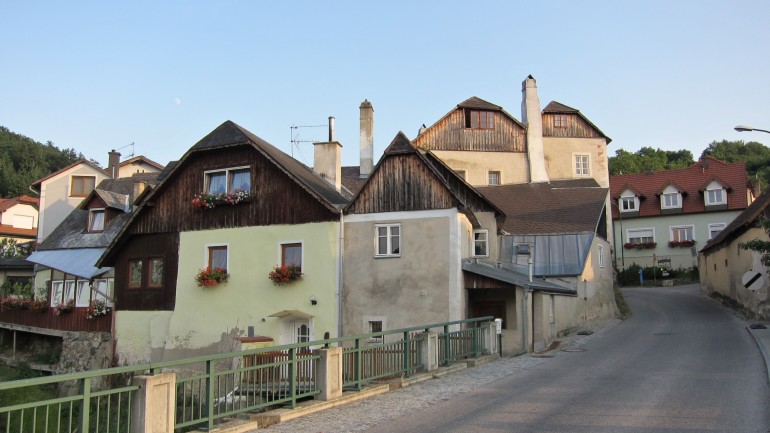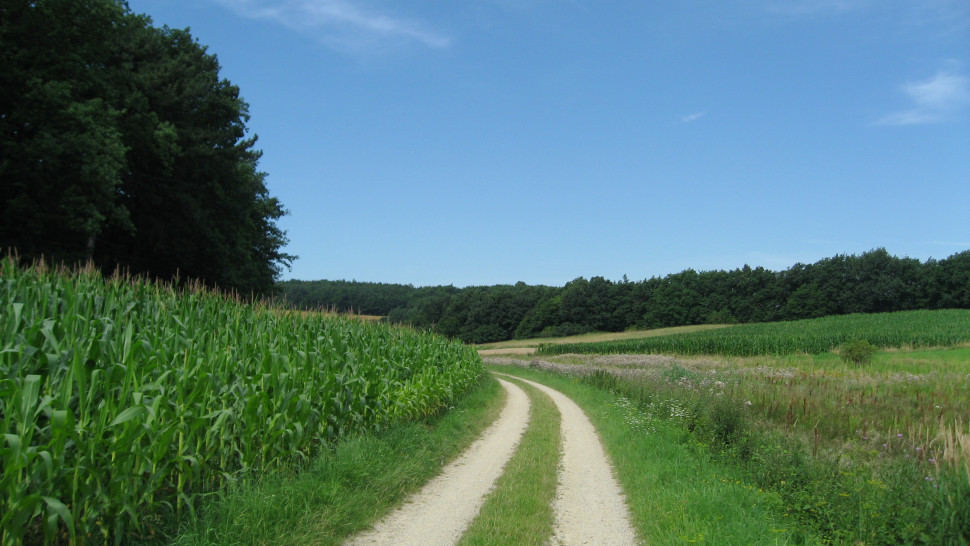The section of the Austrian Jakobsweg (Way of St. James) from Göttweig to Melk was the first to be marked. In some places, steles have been erected with the strangely esoteric retreats of Paulo Coelho (author of "On the Way of St. James"), taken out of context. The money would have been better spent on marking the Way of St. James throughout Lower Austria. And why have the signs of St. James' Way been reinvented once again? But you can see them well, they are where you need them, and they give reasonable indications of time.
Here we are standing happily in Furth, at the foot of the Göttweiger Berg. The sun is laughing and its laughter will intensify very, very much during the day. We expect temperatures of over 30 degrees.
They're digging up the street in Furth. That doesn't bother us as pedestrians. We go through the cellar alley to the Zellergraben.
When I look for the sign "Zellergraben", a man immediately offers me help and also apricots as food for the journey. Thanks!
The Zellergraben (zeller ditch) is not only called so, it is also one. Impressive loess walls provide cool shade. The loess nourishes the vines, which thrive magnificently above it.
Soon the path leads through the vineyards.
It's worth taking a look back. Göttweig Abbey is resplendent on the Austrian Monte Casino.
The Roman town of Mautern is reached after just less than one hour.
The originally gothic parish church of St. Stephan shines in a baroque dress. In the foreground a Roman wall (with the exception of the fire station).
The gothic choir in the interior of St. Stephan is still clearly visible.
St. Nepomuk on the left side welcomes us.
![]()
My Nepomuk collection is happy about a new addition.
Mauterndorf is reached after a short stretch of road.
The bridge over the Mauternbach is guarded by a very small Nepomuk
Click on him!
In Mauterdorf, the road climbs a little further uphill.

The scene changes abruptly. We climb uphill along an old Roman path.
From this wayside shrine on, there are no more asphalt roads.
The signpost says: Maria-Langegg 4h
Soon we enjoy the view of the Danube. In the background on the right is Mautern with the Church of St. Stephen.

The signposted path leads through the village of Oberbergern. We chose the shorter variant of Lindenthal and walk through the forest and on this beautiful path (picture) - a good decision.
A resting place on the Way of St. James invites you to take a break. Far in the background, one sees Göttweig Abbey for the last time.
From this rest area we follow the way of Lindenthal and not the yellow signs.
The signposted path via "die Sieben Gräber", "Rotes Kreuz" and "Herrenplatzl" is certainly the more beautiful and interesting one, but also the longer one.
We follow the descriptions of Lindenthal into the Seeleitengraben. Picture: Descent into the ditch.
Pilgrimages to Lindenthal's guide can become an adventure. There are no markings and the paths are often barely visible.
In the Seeleitengraben a long forest path leads uphill.
The turnoff at the end of the trench to the left is a must. The forest path turns off to the right. However, Lindenthal's map does not include a right-hand bend. So back and there we see it - the inconspicuous turnoff. Lindenthal's instruction: "At the next fork, we climb relatively steep up a gully way to the left side.
At Kreuzberg the paths are reunited and we follow the yellow signs.
In the middle of the picture a way marker:
"Austrian Way of St. James, section Göttweig - Melk"
Here we are at the "Kastlkreuz". Now it's all downhill to Maria Langegg.
After the descent in the forest we reach the stage destination "Maria Langegg".

